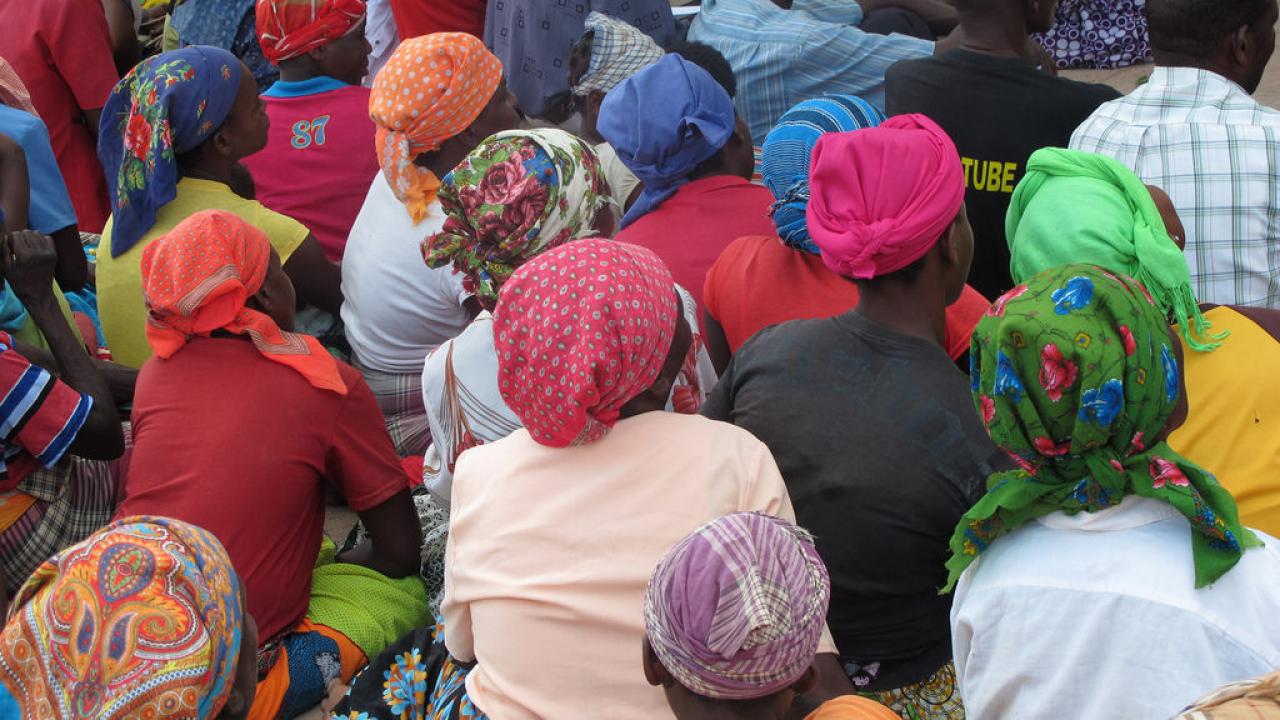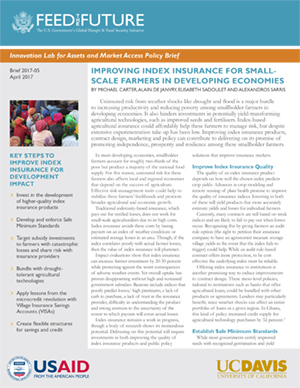
Uninsured risk from weather shocks like drought and flood is a major hurdle to increasing productivity and reducing poverty among smallholder farmers in developing economies. It also hinders investments in potentially yield-transforming agricultural technologies, such as improved seeds and fertilizers.
Index-based agricultural insurance could affordably help these farmers to manage risk, but despite extensive experimentation take-up has been low. Improving index insurance products, contract design, marketing and policy can contribute to delivering on its promise of promoting independence, prosperity and resilience among these smallholder farmers.
Key Steps to Improve Index Insurance for Development Impact
- Invest in the development of higher-quality index insurance products
- Develop and enforce Safe Minimum Standards
- Target subsidy investments to farmers with catastrophic losses and share risk with insurance providers
- Bundle with drought-tolerant agricultural technologies
- Apply lessons from the microcredit revolution with Village Insurance Savings Accounts (VISAs)
- Create flexible structures for savings and credit
 In most developing economies, smallholder farmers account for roughly two-thirds of the poor but produce a majority of the national food supply. For this reason, uninsured risk for these farmers also affects local and regional economies that depend on the success of agriculture. Effective risk-management tools could help to stabilize these farmers’ livelihoods and promote broader agricultural and economic growth.
In most developing economies, smallholder farmers account for roughly two-thirds of the poor but produce a majority of the national food supply. For this reason, uninsured risk for these farmers also affects local and regional economies that depend on the success of agriculture. Effective risk-management tools could help to stabilize these farmers’ livelihoods and promote broader agricultural and economic growth.
Traditional indemnity-based insurance, which pays out for verified losses, does not work for small-scale agriculturalists due to its high costs. Index insurance avoids these costs by basing payouts on an index of weather conditions or estimated average losses in an area. Though, if the index correlates poorly with actual farmer losses, then the value of index insurance will plummet.
Impact evaluations show that index insurance can increase farmer investment by 20-30 percent while protecting against the worst consequences of adverse weather events. Yet overall uptake has proven disappointing without high and sustained government subsidies. Reasons include indices that poorly predict losses,[1] high premiums, a lack of cash to purchase, a lack of trust in the insurance provider, difficulty in understanding the product and strong aversion to the uncertainty of the extent to which payouts will cover actual losses.
Index insurance remains a work in progress, though a body of research shows its tremendous potential. Delivering on this potential will require investments in both improving the quality of index insurance products and public policy solutions that improve insurance markets.
Improve Index Insurance Quality
The quality of an index insurance product depends on how well the chosen index predicts crop yields. Advances in crop modeling and remote sensing of plant health promise to improve the quality of insurance indices. Investing in both of these will yield products that more accurately estimate yields and losses for individual farmers.
Currently, many contracts are still based on weak indices and are likely to fail to pay out when losses occur. Recognizing this by giving farmers an audit rule option (the right to petition their insurance company to have an agronomist measure average village yields in the event that the index fails to trigger) could help. While an audit rule-based contract offers more protection, to be cost effective the underlying index must be reliable.
Offering index insurance to institutions is another promising way to induce improvements to contract design. These meso-level policies, tailored to institutions such as banks that offer agricultural loans, could be bundled with other products or agreements. Lenders may particularly benefit, since weather shocks can affect an entire portfolio of loans in a given region. In Ghana, this kind of policy increased credit supply for agricultural technology purchases by 32 percent.[2]
Establish Safe Minimum Standards
While most governments certify improved seeds with recognized germination and yield standards, there is no equivalent consumer protection standard for index insurance. The development and enforcement of a Safe Minimum Standard (SMS) for index insurance quality could prevent the sale of low-quality, risk-laden contracts that create distrust among farmers and undercut the market.
Standard economic tools offer ways of measuring index insurance quality. They can assess the probability that a contract fails to pay when there is a loss and how payments are distributed. They can also estimate the relative value to a household of the money spent on premiums depending on how deep their losses or how dire their circumstances as a consequence of a contract failure.
A SMS should also be based on pricing. Despite the willingness of many governments to subsidize it, the pricing of index insurance in most developing countries appears high. While there is no systematic data on global pricing, our pilot projects find typical mark-ups of well above 50 percent, as sparse or low-quality data often leads insurance companies to impose “uncertainty loadings.” This threatens to undercut the market and perpetuate the low productivity that insurance is designed to alleviate.
Smarter Subsidy Investments
A potentially budget-neutral alternative to providing an across-the-board discount for insurance would be to provide all farmers completely free insurance to cover cases in which yields are predicted to be less than 50 percent of their average value or another catastrophic loss threshold. Payouts to these farmers, who are more at risk of falling into a poverty trap, will have a larger relative impact than for those who experience smaller losses.
Providing free insurance at this risk layer may not only lower the overall cost of insurance, but it will create a minimum market size. Individuals or institutions could have the option to purchase additional insurance to cover smaller losses.
Governments could also follow the recent example of the World Bank Group’s Global Index Insurance Facility (GIIF) and African Reinsurance Corporation (Africa Re) plan to carry out risk-sharing to induce affordable insurance products.[3] Under this arrangement, a government or institution would reimburse insurers above a set loss ratio. This decreases risk and costs for insurers and could lead to lower premiums for farmers.
Bundle with Stress-tolerant Technology
Significant advances have been made in releasing seed varieties that have tolerance to shocks such as flood, drought and extreme temperatures. In a study for the state of Orissa, India[4] farmers randomly allocated flood-tolerant rice increased their investment in fertilizers and other inputs, paralleling findings on the impact of index insurance.
And yet, these new stress tolerant varieties offer protection over only a limited range. Index insurance could fill in where the built-in seed protection ends. We are currently testing the outcomes of this innovation in Tanzania and Mozambique with a randomized controlled trial that offers farmers stress-tolerant seeds both with and without matched insurance protection.
Apply Lessons from Microcredit
Lending to those with little wealth was considered infeasible until the microfinance revolution established joint-liability borrowing groups. Micro-insurance could take a page from the micro-credit playbook and establish Village Insurance Savings Accounts (VISAs) within existing local finance groups.[5] The Nirdhan Utthan Bank in Nepal already regularly collects lockbox savings from village savings groups across rural areas, with individual savings accounts dedicated in particular to buying health insurance. Applying the same principal to agricultural insurance could enable farmers to save the money needed for insurance.
Savings group meetings could also serve as a way of disseminating information on insurance and implementing savings plans to assure that farmers have the cash to buy insurance when it is needed. The transfer of group funds to a formal financial institution offers a natural way of bundling purchases for villagers who reside in the same insurance zone and for households to mix savings, insurance and credit as complementary risk management mechanisms.
Flexibility for Savings and Credit
Savings and credit are less costly ways to manage risk, though both remain out of reach for many small-scale farmers. BRAC in Bangladesh is experimenting with contingent emergency credit that, like index insurance, is released in the event of a shock.[6] However, only 40 percent of clients are approved, and the amount is limited to half of a borrower’s most recent regular loan.
Farmers with low savings and no credit history may have no choice other than insurance, but insurance is effectively less expensive if it underwrites greater investments and expected income. In this case, a farmer can then begin to accumulate financial and reputational assets that allow access to savings and credit. This suggests that the optimal risk management portfolio will necessarily change over time as a farmer’s overall circumstances improve.
Michael Carter, a UC Davis professor of agricultural and resource economics, is the director of the Feed the Future Innovation Lab for Assets and Market Access.
Alain de Janvry and Elisabeth Sadoulet are professors of agricultural and resource economics at UC Berkeley.
Alexandros Sarris is an Assistant Professor of International Law at Leiden University College.
[1] High “basis risk”
[2] Miranda, et al. 2017. “Insured Loans Increase Credit Access and Farming Technology Adoption in Ghana.” Policy Brief. AMA Innovation Lab.
[3] World Bank Group. 2017. “A New Risk Sharing Facility to Lower Premiums for Africa’s Farmers.” Press Release.
[4] Emerick, Kyle et al., 2016. “Technological innovations, downside risk, and the modernization of agriculture.” The American Economic Review.
[5] Steinmetz et al., 2016. “Village Insurance-Savings Accounts (VISAs).” I4 Brief. AMA Innovation Lab.
[6] de Janvry, Alain et al. 2016. “Emergency Loans: Index Based Credit in Bangladesh.” Working Paper
This report is made possible by the generous support of the American people through the United States Agency for International Development (USAID). The contents are the responsibility of the Feed the Future Innovation Lab for Assets and Market Access at UC Davis and do not necessarily reflect the views of USAID or the United States Government.
